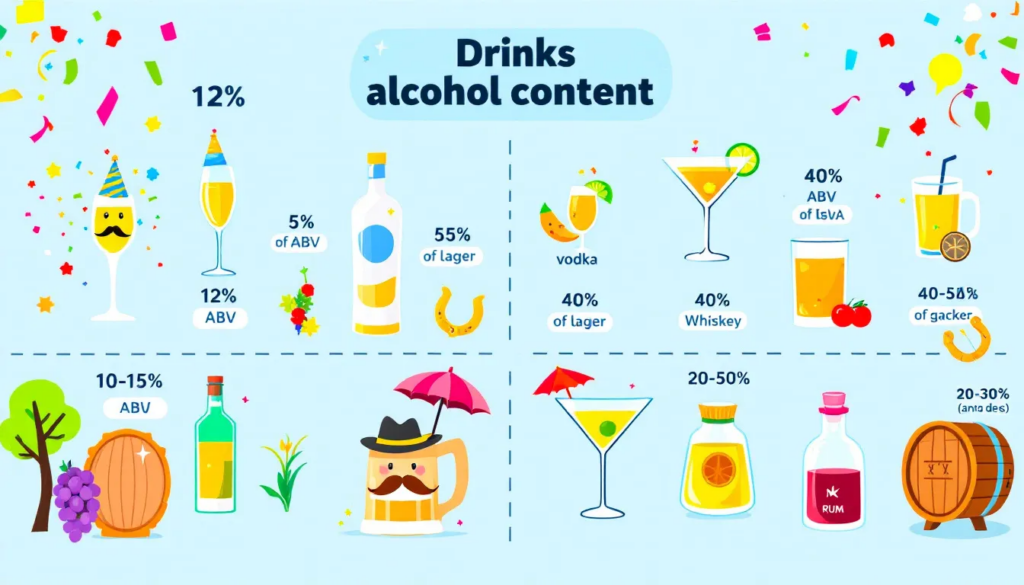
Alcohol comes in many forms, each with its unique uses and effects. In this guide, we’ll explore the types of alcohol, focusing on ethanol, methanol, and isopropanol. You’ll discover where you might encounter these alcohols, their safe uses, and their impact on health. By the end, you’ll understand the roles these alcohols play in both daily life and specific applications.
Key Takeaways
Ethanol is the only type of alcohol safe for human consumption, widely used in alcoholic beverages like beer, wine, and spirits.
Methanol and isopropanol are toxic and primarily used in industrial applications, posing serious health risks if ingested.
Alcoholic beverages are categorized into fermented and distilled types, each with varying alcohol content and cultural significance.
Table of Contents
Types of Alcohol: A Comprehensive Guide to Alcoholic Beverages
Alcohol exists in various forms, each with distinct properties and uses. There are six primary types of alcohol. These include ethanol, methanol, propanol, butanol, pentanol, and hexanol. However, the three primary types used by humans are ethanol, methanol, and isopropanol. Among these, ethanol is the only type safe for human consumption.
Ethanol is commonly referred to as ethyl alcohol. It is the chemical name for the alcohol present in all alcoholic beverages. This substance is soluble in water. It consists of two carbon atoms, one oxygen atom, a hydroxyl group, and several hydrogen atoms. Ethanol can be produced in two forms: undistilled and distilled. The main categories of alcoholic beverages include base liquors, liqueurs, wine, and beer.
Alcohol is categorized by the National Institute on Alcoholism and Alcohol Abuse into beer, malt liquor, table wine, fortified wine, liqueur, brandy, and distilled spirits. Liqueur is defined as alcohol mixed with plant materials and sweeteners to at least 2.5% by weight. These categories highlight the variety and unique characteristics of alcoholic beverages.
Introduction
Understanding the different types of alcohol is more than just a matter of curiosity; it’s essential for making informed choices about alcohol consumption. With alcohol impacting the central nervous system and various organs in the human body, knowing what you’re drinking can make a significant difference in health outcomes.
This knowledge not only enhances appreciation for the unique qualities of different alcoholic beverages but also guides responsible drinking practices. Knowledge of the types of alcohol and their effects allows for better decision-making, positively impacting health and cultural practices.
Overview of Alcohol Types
The world of alcohol is vast, encompassing various chemical compounds and categories of alcoholic beverages. There are six main types of alcohol. They are ethanol, methanol, propanol, butanol, pentanol, and hexanol. However, the types most commonly used by humans are isopropyl, methyl, and ethyl alcohol.
Ethanol, commonly referred to as ethyl alcohol, is the most well-known form. It is also the only type that is safe for human consumption. Its chemical formula is C2H5OH, and it is produced in two forms: undistilled and distilled. Undistilled forms include beer and wine, while distilled forms include spirits like whiskey and vodka. These categories of alcoholic beverages—base liquors, liqueurs, wine, and beer—offer a wide range of flavors and alcohol content.
Liqueurs, for example, are distilled spirits that have been sweetened and flavored with various ingredients, providing unique tasting experiences. Understanding these different types of alcohol and their categories is essential for appreciating their cultural significance and the variety available in the market.
Ethanol: The Drinking Alcohol
Ethanol is commonly referred to as ethyl alcohol. It is the chemical name for the alcohol present in all alcoholic beverages. It is the only type of alcohol commonly recognized as safe for human consumption and is primarily used for recreational purposes.
Its production and uses are vast, from being the key ingredient in beer, wine, and spirits to playing a significant role in various industrial applications.
Production of Ethanol
Ethanol is produced through the fermentation process, where sugars are converted into alcohol by yeast. Common raw materials for ethanol production include barley, wheat, grapes, and other grains and fruits. This fermentation process is the foundation for creating a variety of alcoholic beverages, each with its unique flavor profile and alcohol content.
The distillation process can further refine ethanol, increasing its alcohol concentration and resulting in distilled alcoholic beverages like whiskey and vodka. Understanding the production of ethanol provides insight into the craftsmanship behind your favorite drinks and the science that makes them possible.
Common Uses of Ethanol
Ethanol is the main type of alcohol in beverages such as beer, wine, and spirits, providing their alcohol content. It is consumed for recreational purposes, which has led to various cultural practices around drinking. Beyond beverages, ethanol is widely used in hand sanitizers due to its ability to kill a wide range of bacteria and viruses, making it an effective disinfectant.
In addition to its role in beverages and sanitizers, ethanol serves as a solvent in industrial processes, contributing to product formulations in various industries. Its versatility extends beyond consumption, highlighting its importance in everyday life.
Health Effects of Ethanol
Ethanol enhances the impact of GABA, which can lead to a calming effect on the brain. However, it can also damage the liver, brain, and other organs, impairing coordination and judgment, posing significant health risks. Understanding these health effects is essential for responsible drinking, balancing the potential benefits with the risks to health and safety.
Responsible drinking practices can help mitigate some of the risks associated with ethanol consumption. Awareness of both the short-term and long-term effects of alcohol is crucial for making informed decisions about your drinking habits.
Methanol: The Industrial Alcohol
Methanol, also known as wood alcohol, is primarily used in industrial applications. While it is FDA approved for use in hand sanitizers, its ingestion poses severe health risks, including poisoning and potential death.
Understanding the industrial applications and dangers of methanol is crucial for safety in its handling and use.
Production and Uses of Methanol
Methanol is commonly utilized as an industrial-strength solvent, finding applications in products like paint removers, antifreeze, and printing ink. It is also used in various applications, including insecticide and fungicide formulations. Its production involves the distillation of wood or other biomass, highlighting its industrial importance.
Despite its usefulness, methanol’s toxic nature requires careful handling and strict regulations to prevent accidental ingestion or exposure. Awareness of its applications and risks can ensure safer use in industrial and household products.
Dangers of Methanol
Methanol is a toxic type of alcohol that poses significant health risks when ingested. Ingestion can lead to severe health complications, including temporary or permanent blindness due to optic nerve damage. Understanding these risks underscores the importance of proper labeling and safety measures when using methanol-containing products.
Ingesting methanol can be fatal and leads to serious health complications. Immediate medical attention is required in cases of methanol poisoning to prevent long-term damage or death. Awareness and education about methanol’s dangers are essential for preventing accidental poisoning.
Isopropanol: Rubbing Alcohol
Isopropanol, commonly known as rubbing alcohol, is widely used for cleaning and disinfecting surfaces. Unlike ethanol, it is not safe for human consumption and serves different purposes in household and industrial settings.
Uses of Isopropanol
Isopropanol is essential in daily life, particularly for its cleaning and antiseptic properties. Common uses include household cleaning, disinfecting surfaces, sanitizing electronics, refreshing sponges, cleaning stainless steel, and antiseptic use. It is also utilized in paint thinners and perfumes.
Despite its widespread use, isopropanol requires safety considerations due to its toxicity when ingested. Understanding its applications and handling it with care can prevent accidental exposure to its harmful effects.
Risks of Isopropanol Ingestion
Ingesting isopropanol can lead to serious health consequences, including severe toxicity that may result in coma or death. Common symptoms of isopropanol poisoning include dizziness, confusion, headache, and require immediate medical attention. The rapid absorption of isopropanol by the body increases the urgency for medical intervention.
Ingesting household products like hand sanitizers, which contain isopropanol, can be extremely harmful to internal cells, tissues, and organs. Awareness of these risks is crucial for preventing accidental poisoning and ensuring safe use of isopropanol-containing products.

Overview of Alcohol Types
The world of alcohol is vast, encompassing various chemical compounds and categories of alcoholic beverages. There are six main types of alcohol. They are ethanol, methanol, propanol, butanol, pentanol, and hexanol. However, the types most commonly used by humans are isopropyl, methyl, and ethyl alcohol.
Ethanol, commonly referred to as ethyl alcohol, is the most well-known form. It is also the only type that is safe for human consumption. Its chemical formula is C2H5OH, and it is produced in two forms: undistilled and distilled. Undistilled forms include beer and wine, while distilled forms include spirits like whiskey and vodka. These categories of alcoholic beverages—base liquors, liqueurs, wine, and beer—offer a wide range of flavors and alcohol content.
Liqueurs, for example, are distilled spirits that have been sweetened and flavored with various ingredients, providing unique tasting experiences. Understanding these different types of alcohol and their categories is essential for appreciating their cultural significance and the variety available in the market.
Ethanol: The Drinking Alcohol
Ethanol is commonly referred to as ethyl alcohol. It is the chemical name for the alcohol present in all alcoholic beverages. It is the only type of alcohol commonly recognized as safe for human consumption and is primarily used for recreational purposes.
Its production and uses are vast, from being the key ingredient in beer, wine, and spirits to playing a significant role in various industrial applications.
Production of Ethanol
Ethanol is produced through the fermentation process, where sugars are converted into alcohol by yeast. Common raw materials for ethanol production include barley, wheat, grapes, and other grains and fruits. This fermentation process is the foundation for creating a variety of alcoholic beverages, each with its unique flavor profile and alcohol content.
The distillation process can further refine ethanol, increasing its alcohol concentration and resulting in distilled alcoholic beverages like whiskey and vodka. Understanding the production of ethanol provides insight into the craftsmanship behind your favorite drinks and the science that makes them possible.
Common Uses of Ethanol
Ethanol is the main type of alcohol in beverages such as beer, wine, and spirits, providing their alcohol content. It is consumed for recreational purposes, which has led to various cultural practices around drinking. Beyond beverages, ethanol is widely used in hand sanitizers due to its ability to kill a wide range of bacteria and viruses, making it an effective disinfectant.
In addition to its role in beverages and sanitizers, ethanol serves as a solvent in industrial processes, contributing to product formulations in various industries. Its versatility extends beyond consumption, highlighting its importance in everyday life.
Health Effects of Ethanol
Ethanol enhances the impact of GABA, which can lead to a calming effect on the brain. However, it can also damage the liver, brain, and other organs, impairing coordination and judgment, posing significant health risks. Understanding these health effects is essential for responsible drinking, balancing the potential benefits with the risks to health and safety.
Responsible drinking practices can help mitigate some of the risks associated with ethanol consumption. Awareness of both the short-term and long-term effects of alcohol is crucial for making informed decisions about your drinking habits.
Methanol: The Industrial Alcohol
Methanol, also known as wood alcohol, is primarily used in industrial applications. While it is FDA approved for use in hand sanitizers, its ingestion poses severe health risks, including poisoning and potential death.
Understanding the industrial applications and dangers of methanol is crucial for safety in its handling and use.
Production and Uses of Methanol
Methanol is commonly utilized as an industrial-strength solvent, finding applications in products like paint removers, antifreeze, and printing ink. It is also used in various applications, including insecticide and fungicide formulations. Its production involves the distillation of wood or other biomass, highlighting its industrial importance.
Despite its usefulness, methanol’s toxic nature requires careful handling and strict regulations to prevent accidental ingestion or exposure. Awareness of its applications and risks can ensure safer use in industrial and household products.
Dangers of Methanol
Methanol is a toxic type of alcohol that poses significant health risks when ingested. Ingestion can lead to severe health complications, including temporary or permanent blindness due to optic nerve damage. Understanding these risks underscores the importance of proper labeling and safety measures when using methanol-containing products.
Ingesting methanol can be fatal and leads to serious health complications. Immediate medical attention is required in cases of methanol poisoning to prevent long-term damage or death. Awareness and education about methanol’s dangers are essential for preventing accidental poisoning.
Isopropanol: Rubbing Alcohol
Isopropanol, commonly known as rubbing alcohol, is widely used for cleaning and disinfecting surfaces. Unlike ethanol, it is not safe for human consumption and serves different purposes in household and industrial settings.
Uses of Isopropanol
Isopropanol is essential in daily life, particularly for its cleaning and antiseptic properties. Common uses include household cleaning, disinfecting surfaces, sanitizing electronics, refreshing sponges, cleaning stainless steel, and antiseptic use. It is also utilized in paint thinners and perfumes.
Despite its widespread use, isopropanol requires safety considerations due to its toxicity when ingested. Understanding its applications and handling it with care can prevent accidental exposure to its harmful effects.
Risks of Isopropanol Ingestion
Ingesting isopropanol can lead to serious health consequences, including severe toxicity that may result in coma or death. Common symptoms of isopropanol poisoning include dizziness, confusion, headache, and require immediate medical attention. The rapid absorption of isopropanol by the body increases the urgency for medical intervention.
Ingesting household products like hand sanitizers, which contain isopropanol, can be extremely harmful to internal cells, tissues, and organs. Awareness of these risks is crucial for preventing accidental poisoning and ensuring safe use of isopropanol-containing products.
Categories of Alcoholic Beverages
Alcoholic beverages are categorized primarily into two groups: fermented (undistilled) and distilled. This distinction is based on the production methods and ingredient types, leading into detailed discussions on fermented, distilled beverages, and distilled and undistilled alcohol.
Fermented Beverages
Fermented beverages are produced using fermented grains, fruits, or sugars through the fermentation process, where sugar is converted into ethanol by yeast.
Examples include:
Wine
Beer
Cider
Sake
These beverages often have a lower alcohol content compared to distilled drinks but offer a wide range of mixed drinks and styles.
Sake, for instance, typically has an alcohol content of about 16% ABV. Understanding the fermentation process and the ingredients used in these beverages can enhance appreciation for their unique qualities and cultural significance.
Distilled Beverages
Distilled beverages, also known as distilled spirits, undergo an additional process after fermentation to increase their alcohol content. The process of distillation involves heating the fermented substance to vaporize the distilled alcohol and then condensing it back into liquid form, effectively removing water and concentrating the alcohol.
Common types of distilled spirits include whiskey, vodka, rum, gin, and tequila. Each of these spirits has unique production methods and flavor profiles. For example, whiskey is produced from fermented grain mash, while rum is made from sugarcane molasses or juice.
Appreciating the complexity and strength of distilled beverages comes from understanding their production process.
Popular Types of Alcoholic Drinks
Popular alcoholic drinks vary widely across cultures and preferences, including undistilled drinks like beer and wine, as well as distilled spirits. Each type of drink has its own unique characteristics and cultural significance, making them integral to various social and celebratory practices.
Beer
Beer is the most popular alcoholic beverage worldwide, enjoyed by millions for its diverse range of flavors and styles.
Beer commonly contains several key ingredients:
Hops
Barley
Yeast
Water
The brewing process involves fermenting these ingredients to produce a beverage with a typical alcohol content range of 3% to 12% ABV, with craft beers often exceeding this range.
The amount of pure alcohol in a standard beer is about 14 grams, making it a moderate option for alcohol consumption compared to stronger spirits. Understanding the ingredients and brewing process can enhance your appreciation for this beloved drink.
Wine
Wine is another popular alcoholic beverage, produced by fermenting grape juice. Table wines are classified as white, red, or pink, each offering a variety of flavors and alcohol content. Fortified wines, such as Port and Sherry, have distilled spirits like brandy added to them, which increases their alcohol content and gives them a unique taste.
Examples of fortified wines include Marsala, Madeira, and Vermouth, with the latter being a popular ingredient in cocktails. Knowing the types of wine and their production processes enhances enjoyment of this sophisticated drink.
Spirits
Spirits, or distilled alcoholic beverages, are known for their high alcohol content and diverse flavors. Whiskey, for example, is made from a mixture of grain mash and comes in various flavored variants like Peanut Butter Whiskey and Fireball Whisky. Tequila, primarily made from the blue agave plant, is categorized into styles such as blanco, reposado, and añejo.
Other popular spirits include rum, made from sugarcane products, and gin, which gets its signature taste from juniper berries. Brandy is distilled from wine and is typically enjoyed as a digestif, while vodka is known for its neutral flavor and versatility in cocktails. Understanding these spirits and their unique characteristics can enhance your appreciation and enjoyment of these potent drinks.
Alcohol Content in Various Drinks

Understanding ABV
ABV measures the ethanol content in a beverage. It is expressed as a percentage of the total volume. This measure is important for responsible drinking as it helps gauge alcohol consumption and informs drinking choices. Alcohol proof can be calculated by doubling the percentage of alcohol by volume, providing another way to understand a drink’s strength. Factors contributing to the variability of alcohol content in beverages include the production process, fermentation, and distillation. Different types of alcohol have varying effects on consumption patterns. Spirits are more concentrated and can lead to quicker intoxication than beer or wine. Understanding ABV can help you make more informed decisions about your alcohol intake and enjoy your drinks responsibly.Alcohol Content Comparison
ABV varies among different types of alcoholic beverages; beer typically ranges from 3% to 12%, while wine is around 9% to 16%, and spirits usually exceed 20% ABV. For example, whiskey typically has an ABV range of 40% to 50%, and vodka in the United States generally has a standard alcohol concentration of 40% ABV. Fortified wines typically have higher alcohol content than table wines, averaging around 20% ABV. Understanding these differences can help you choose drinks that align with your preferences and tolerance levels, ensuring a more enjoyable and safe drinking experience.Health Implications of Alcohol Consumption
Alcohol consumption has various health implications, ranging from short-term effects like intoxication to long-term risks such as addiction and organ damage. Understanding these effects is crucial for responsible drinking and maintaining good health.Short-term Effects
Alcohol is classified as a depressant, meaning it slows down the central nervous system. Immediate effects of alcohol consumption can include intoxication, hangovers, alcohol poisoning, and an increased risk of accidents due to impaired judgment and coordination. These short-term effects highlight the importance of drinking in moderation and being aware of how much alcohol you consume. Higher concentrations of alcohol in drinks can lead to quicker intoxication and a higher risk of alcohol poisoning. Understanding these risks can help you make safer choices when consuming alcoholic beverages.Long-term Risks
Chronic alcohol use can lead to serious long-term health risks, including:- addiction
- cognitive impairment
- liver damage
- heart disease
- an increased risk of certain cancers

Alcohol has played a significant role in human culture for thousands of years, essential for social, religious, and celebratory practices. Different types of alcohol carry unique cultural significance, influencing rituals and social gatherings across various societies.
Alcohol in Celebrations
In numerous cultures, sharing a drink is a common way to celebrate significant events, such as weddings and births, reinforcing social bonds. Certain holidays feature traditional drinks like champagne for toasting on New Year’s Eve. Drinking habits are significantly influenced by cultural contexts, with certain societies embracing communal drinking practices while others impose restrictions.
Distinct alcoholic drinks are commonly associated with cultural festivities, such as champagne for New Year’s and sake for Japanese ceremonies. Understanding the cultural significance of alcohol can enhance your appreciation for these traditions and the role they play in social bonding.
Social Drinking Norms
Societal attitudes towards alcohol consumption are often steeped in tradition, with specific norms governing drinking practices. Drinking practices vary across cultures, with unique customs associated with alcohol consumption. Social norms play a significant role in drinking behaviors, influencing aspects such as toasting and acceptable drinking ages.
Overall, societal attitudes shape the framework within which social drinking occurs, affecting practices and perceptions of alcohol consumption. Understanding these social norms can help you navigate social situations involving alcohol with respect and awareness.
Household Products Containing Alcohol
Ethanol is present in many consumer products, including disinfectants and personal care items. While these products serve useful purposes, they can pose serious health risks if consumed improperly.
Understanding the alcohol content in household products is crucial for safety.
Mouthwash
Mouthwash can contain alcohol content of up to 27%, making it effective for eliminating bacteria responsible for bad breath. However, drinking mouthwash is dangerous because it contains harmful ingredients and has high alcohol content.
Understanding these risks can prevent accidental ingestion and ensure safe use.
Hand Sanitizer
Hand sanitizers usually have an alcohol concentration of at least 60% to effectively eliminate germs. They often contain isopropyl alcohol, which can be dangerous if ingested in large amounts. High levels of alcohol in hand sanitizers are intended for topical use only and can be dangerous if mistakenly ingested.
Isopropyl alcohol is often used in hand sanitizers due to its effectiveness as a disinfectant. Understanding the risks associated with hand sanitizer can prevent accidental ingestion and ensure safe use.
Vanilla Extract
Vanilla extract contains a minimum alcohol content of 35%, making it a potent ingredient in baking and cooking. However, excessive consumption of vanilla extract can lead to ethanol poisoning, with symptoms like slowed breathing, heart rate, and movement.
Understanding these risks can prevent misuse and ensure safe use in culinary applications.
Summary
In conclusion, understanding the different types of alcohol and their various uses is essential for making informed decisions about alcohol consumption. From the chemical properties of ethanol to the cultural significance of alcoholic beverages, this comprehensive guide provides valuable insights into the world of alcohol. Remember to drink responsibly and appreciate the rich history and craftsmanship behind your favorite drinks.
Frequently Asked Questions
What are the main types of alcohol used by humans?
The main types of alcohol used by humans are ethanol, methanol, and isopropanol. Ethanol is commonly found in alcoholic beverages, while methanol and isopropanol are primarily used in industrial applications and as disinfectants.
How is ethanol produced?
Ethanol is produced by fermenting sugars with yeast, utilizing raw materials such as barley, wheat, grapes, and various fruits. This process effectively converts these resources into alcohol.
What are the health risks of methanol?
Ingesting methanol poses severe health risks, such as poisoning, blindness, and even death. It is crucial to avoid exposure to this toxic substance.
What is the alcohol content in mouthwash?
Mouthwash can contain up to 27% alcohol, which makes it effective for killing bacteria but poses risks if swallowed.
What are the long-term risks of chronic alcohol consumption?
Chronic alcohol consumption poses significant long-term health risks, including liver damage, heart disease, addiction, cognitive impairment, and a higher risk of certain cancers. It is crucial to be aware of these dangers to make informed choices about alcohol use.
Dr. Mitchell G. Cohen is a board-certified Internal Medicine specialist with over 34 years of experience in patient-centered healthcare. A graduate of Hahnemann University School of Medicine, Dr. Cohen completed his internship at the University Health Center of Pittsburgh, where he gained invaluable hands-on experience. He is also a certified addiction specialist, holding membership with the American Society of Addiction Medicine (ASAM).
Currently based in Nashua, NH, Dr. Cohen is affiliated with Saint Joseph Hospital, where he provides comprehensive care focusing on both internal medicine and addiction treatment. His expertise includes prevention, diagnosis, and management of adult diseases, as well as specialized care for individuals facing substance use disorders.
Dr. Cohen is committed to fostering open communication, ensuring his patients are fully informed and empowered to make confident decisions about their health and treatment options.

MD Mitchell Grant Cohen
Dr. Mitchell G. Cohen is a board-certified Internal Medicine specialist with over 34 years of experience in patient-centered healthcare. A graduate of Hahnemann University School of Medicine, Dr. Cohen completed his internship at the University Health Center of Pittsburgh, where he gained invaluable hands-on experience. He is also a certified addiction specialist, holding membership with the American Society of Addiction Medicine (ASAM).
Currently based in Nashua, NH, Dr. Cohen is affiliated with Saint Joseph Hospital, where he provides comprehensive care focusing on both internal medicine and addiction treatment. His expertise includes prevention, diagnosis, and management of adult diseases, as well as specialized care for individuals facing substance use disorders.
Dr. Cohen is committed to fostering open communication, ensuring his patients are fully informed and empowered to make confident decisions about their health and treatment options.






